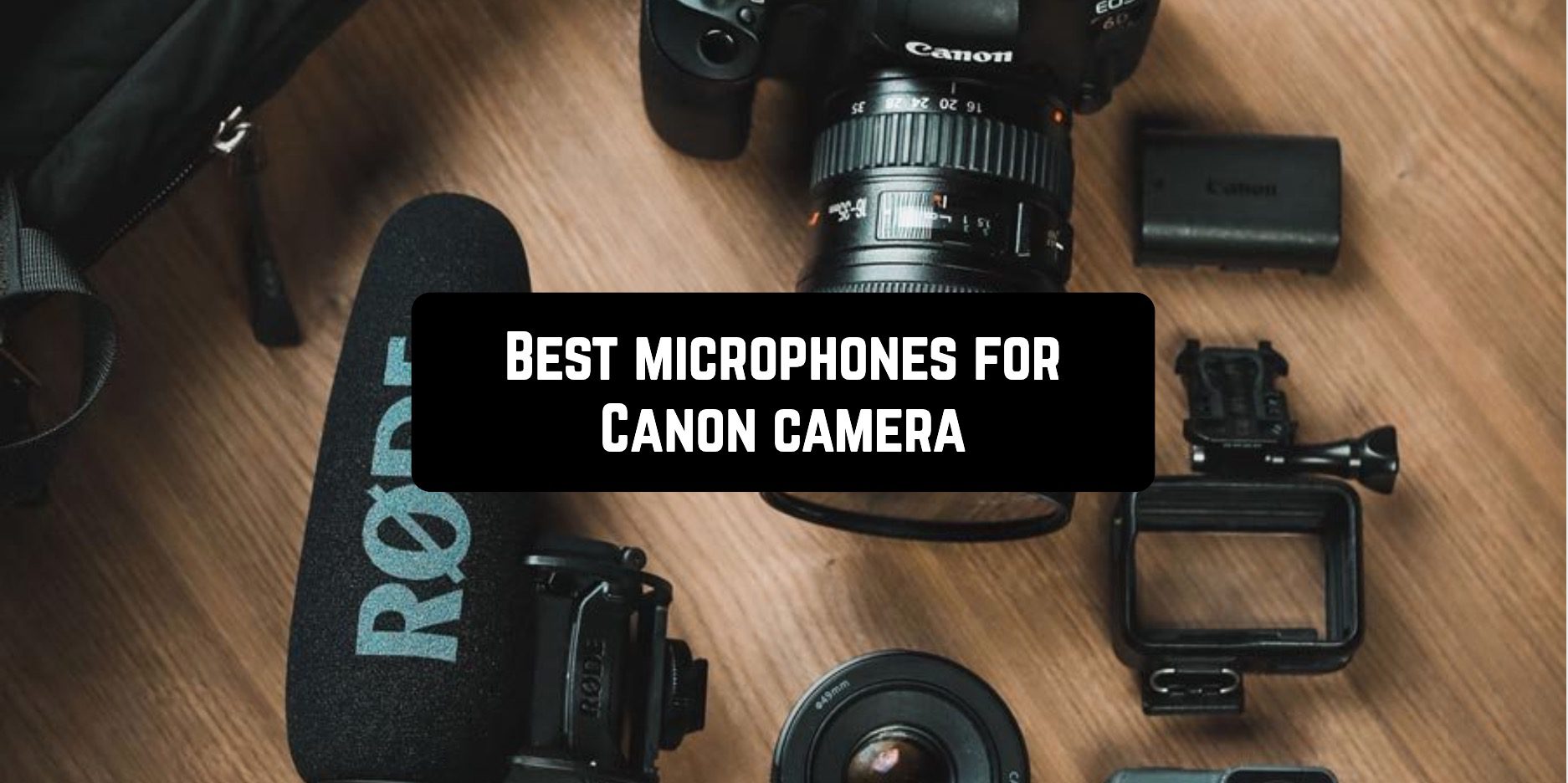Modern SLR cameras and camcorders allow you to shoot high-quality video, but there are problems with sound, as the microphone is of poor quality. For this reason, it is worth buying a good microphone for the camera and you can shoot high-quality video with good sound. To the attention of our readers, we offer 10 Best microphones for Canon camera.
Check also 9 Best DSLR Camera Microphones for videos]
Rode VideoMic GO
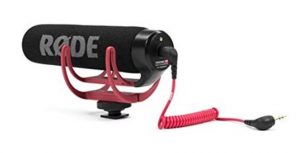
In the process of recording, the microphone doesn’t catch unnecessary noise. VideoMic is made of polycarbonate, which makes it reliable for everyday use. A microphone can withstand minor shocks from falls or other external contacts.
A high-pass filter is available in the Rode Video Microphone. This feature is useful when recording outside. The rumble of wind and other unwanted interference on a busy highway in the middle of the working day are suppressed.
Rode VideoMic Go is a very good microphone, however, it is the largest of the tested analogs. Of course, if we had a choice between a built-in mono microphone on the camera and Rode VideoMic, then we would prefer the second option.
TAKSTAR SGC-598
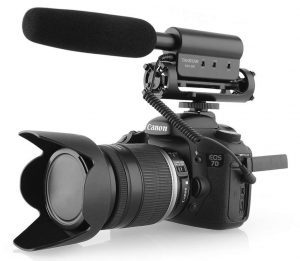
The cardioid orientation of the microphone will help effectively reduce environmental noise. The sensitivity switch 10 dB and a low-pass filter 200 Hz allow you to operate the settings on the go.
The main features Takstar SGC 598:
- Standard universal connectors;
- Impact-resistant construction;
- Power supply: 1.5V AA, service life up to 100 hours;
- It has two sound recording modes.
The Takstar SGC-598 microphone is designed for high-quality sound during video recording. Its compact size and lightweight allow it to be carried in a bag from a photo/video camera. The kit includes a branded cover and a fur windshield.
Sennheiser MKE 400
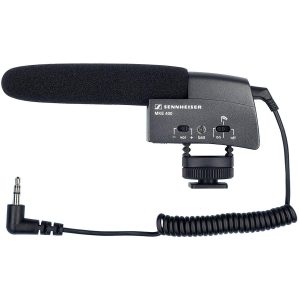
Sennheiser MKE 400 is a regular mono microphone that has been tested for compatibility with the Canon EOS 5D Mark II camera. The MKE 400 is the smallest and lightest microphone among all tested. The microphone has a metal structure, 2 sensitivity functions, and a high-pass filter. Powered by one AAA battery. The microphone can be attached to the camera’s hot shoe. The plug for connection is also compatible with the 5D MkII.
The length of the microphone is ideal for continuous use with a camera. You can take pictures all day long (the microphone will not bother you to look into the optical viewfinder), and if you need to record, you will simply need to switch the camera to video recording mode.
On the Sennheiser MKE 400 microphone, there is a special coating that reduces noise caused by the roar of the wind. It also has a number of functions described by us in relation to the previous microphone.
If you pick up the microphone, guided by the practicality and compactness of the product, the Sennheiser MKE 400 is the most suitable device for recording sound. If we had the honor of choosing a mono microphone between the Rode VideoMic and the Sennheiser MKE 400, we would stop at the Sennheiser. Moreover, the Rode VideoMic is slightly inferior to the MKE 400 in terms of recording quality.
Rode Stereo VideoMic Pro
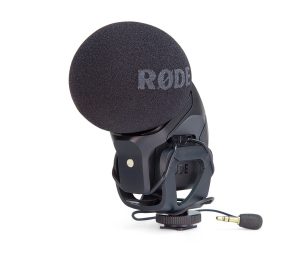
Microphone Rode Stereo VideoMic Pro is built on a perfectly matched pair of high sensitivity 0.5 inches cardiogenic condenser capsules angled at 90 degrees. This allows you to get a wide stereo sound with natural depth.
The Rode Stereo Video Pro microphone has all the features of the Rode Video Pro Microphone and is ideal for digital SLR cameras, semi-professional and professional camcorders. The built-in mounting system provides isolation from vibration and mechanical noise that can affect sound quality. In addition, the lightweight but durable multi-core cable provides excellent acoustic isolation from the camera and provides lower noise compared to traditional audio cables.
On the back of the microphone, there are buttons to control the equalizer and power. The 75 Hz high-pass filter removes noise from air conditioning, transport, or other unwanted noise at low frequencies. Lowering the sensitivity of the microphone to -10 dB, allows you to record noisy events such as live concerts and sporting events.
As with the VideoMic Pro, the output level is increased by +20 dB, which provides high-quality sound when working with SLR cameras. When this feature is activated, the camera’s low-quality preamps provide lower noise and clear recording.
Tascam TM-2X
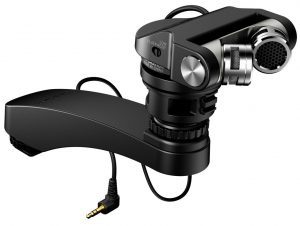
This good stereo model of two connected microphones is designed to solve the problem of isolation from external noise.
For this purpose, there are a switchable low-pass filter, fur wind protection, and a special support structure under the microphone. Thanks to this, the device provides high-quality sound recording.
The Tascam is powered by the camera and requires no batteries or battery. A distinctive feature of the model is its ability to rotate through 180° once attached to the carcass.
This makes it possible to use the microphone to capture sound from different directions or by the movement of the source. Besides, if necessary, the device can be mounted not only on the camera but also on a tripod.
Saramonic Vmic
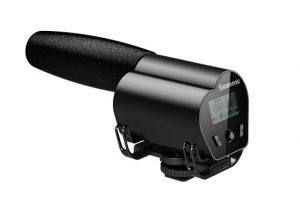
This is another reliable super-cardioid microphone gun. It’s available in two versions. One of them has a flash recorder for recording WAV audio to a MicroSDHC memory card and LCD display, the other version comes without them.
The built-in screen in the first modification noticeably simplifies navigation. It makes the regulation process simple and convenient. Besides, the display is bright enough for use in low light conditions.
The device has an extra 3.5mm headphone input. It allows you to hear in real-time what is recorded by the microphone. Built-in shock absorber and low-pass filter switch suppress extraneous noise. They also improve the clarity of the recording.
The microphone is very easy to mount on the camera. The lightweight metal construction reduces the load during long periods of recording.
Canon DM-E1
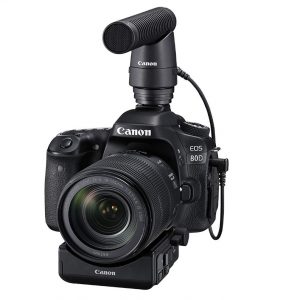
Record rich and realistic sound, for example, the entire range of tones of a musical composition – from violins and flutes to double bass and bass – thanks to the range from 50 Hz to 16 kHz. A sensitivity of -42 dB allows you to record even the quietest sounds.
Complete your videos with great sound with three directional recording modes. Select the 90 or 120-degree mode for high-quality stereo recording depending on the size of the space or use the shotgun mode to clearly record conversations of objects without extraneous noise.
Thanks to its compact and lightweight body, you can carry your microphone everywhere with you. Together with the camera and lens, it forms a neat system for comfortable handheld shooting for a long time.
* Not recommended for use with EOS-1D Mark IV and EOS 550D cameras, as they don’t allow you to manually adjust the volume of an external microphone.
Key Features of the DM ‑ E1 Microphone:
- Compact design;
- Stereo modes 90 Degree/120 Degree;
- Frequency range from 50 Hz to 16 kHz;
- Signal to noise ratio 66 dB, sensitivity –42 dB;
- The built-in power supply of a single button-type lithium cell battery.
Rode VideoMic Pro+
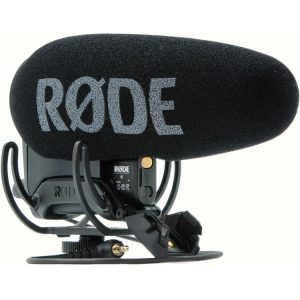
The microphone can be operated either from the Micro-USB connector or from two standard AAA batteries or one rechargeable lithium-ion battery. A special cover is provided for easy power supply replacement.
The microphone also has an automatic power on/off function. It triggers simultaneously with the button on the camera itself.
The small size of the model allows you to install it even on a relatively small portable video camera. In this case, it will not climb into the frame or interfere with the operator.
This advanced model has won a lot of popularity among professionals. Variability of power supplies and a detachable cable make this microphone one of the most convenient and versatile among all devices.
Rode NTG2
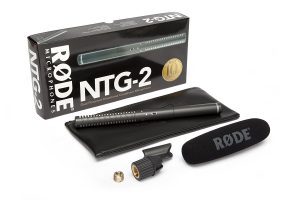
Rode NTG-2 – a thin and light, narrowly-focused microphone-gun for shooting staged scenes and journalistic reports.
This microphone requires additional (phantom) power but can work with any devices, even those that have only linear inputs. It is enough to insert a battery into the microphone, and it can be connected to any video camera or recorder with a line input.
The Rode NTG-2 microphone works in the full frequency range, it is low-noise, very sensitive and is able to effectively cut off background noise from sources outside the action field. For work in the conditions of the street, it can be used with the “DeadCat” fluffy windscreen (purchased separately).
The manufacturer provides a ten-year warranty for ITS Røde NTG-2 product.
BOYA By-M1
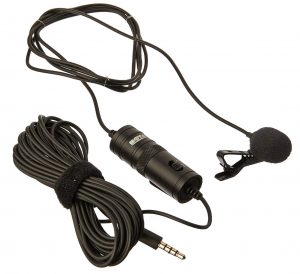
The microphone is equipped with a standard 3.5 mm plug with gold-plated contacts and a six-meter cord, allowing the operator or sound engineer to move a sufficient distance from the subject.
The Boya BY-M1 microphone is quite compact and convenient for transportation. For these purposes, there is even a special soft case in the kit. The technical characteristics of the microphone allow us to talk about the high quality of the device. So, its sensitivity is 30 dB, which ensures the capture of even quiet sounds. The range of captured frequencies is also quite wide – from 65 Hz to 18,000 Hz. This minimizes sound distortion. And wind protection eliminates unnecessary noise.
Advantages:
- Clip-On Mic for Smartphones, DSLR, Camcorders, Audio recorders, PC etc;
- Excellent price/quality ratio;
- High signal to noise ratio (74 dB);
- High sound quality;
- Long cable.
The Boya BY-M1 microphone paired with a camera is well suited for both a vlogger and a journalist for recording interviews with quality that is suitable for broadcast, and for beginners and professional filmmakers.
Advantages of external microphones for cameras
Undoubtedly, the main advantage of on-camera microphones is sound quality. With their appearance, users have the opportunity to shoot video clips anywhere and anytime. That is, you can purchase any camera and create 1080p video quality. But what about sound quality? A microphone for a video camera is an external device that is used to get high-quality sound during video recording.
Types of microphones
The modern electronics market offers several types of microphones:
- Electrodynamic.
- Capacitor.
- Electret.
- Carbon and other various sound recorders.
In order your microphone for a Canon camera to serve faithfully, you must first decide in what conditions it will work and only then select the desired model.
Electrodynamic (bobbin) microphone. The principle of operation is based on the induction of electric current.
The advantage of such microphones is their high durability, reliability, and ease of handling.
- They do not need a power source, they are cheaper than other types, they are not damaged by a loud sound.
- It takes a lot of effort to set the membrane in motion, as it is rather heavy, as a result, the sound quality and duty cycle is worse than that of its competitors.
- They do not work well with weak sounds and are sensitive to interference.
Condenser microphone. An electric current amplifies the signal and transmits it to a capacitor (a membrane with a counter electrode).
Sensitive membrane works well with a quiet sound, the best porosity, the sound of better quality.
- High cost, sensitive to mechanical damage, and moisture, a power source is needed, high sensitivity to extraneous noise.
Carbon microphones. They have poor sound quality, so they are rare, although they used to be very common. They met in each intercom and on each telephone.
Electret Microphones. They are similar in type to condenser microphones, but they do not require an external power source, they have enough batteries. Good for outdoor use. Mainly used in lavalier microphones.
Radius of action
As for the range, the optimal distance is considered to be 50-60 cm, and when using microphones with a high-frequency filter, the distance is reduced to 10 centimeters.
Buying microphones for cameras is not an action for most users of photographic equipment. For a simple man in the street, it is quite enough to have an ordinary, budget model of the camera with a built-in microphone.

